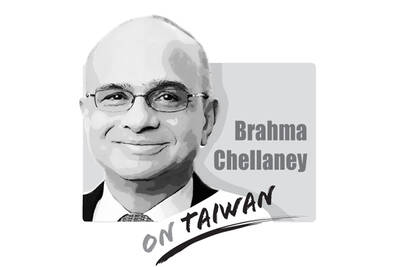On Friday last week, 38 Chinese military aircraft crossed into Taiwan’s southwestern air defense identification zone (ADIZ), the highest single-day tally since records on incursions were made public in September last year. The following day, the number increased to 39 and on Monday Beijing set another record, dispatching 56 aircraft into the same area.
The sharp escalation in China’s “gray zone” campaign against Taiwan caused international commentators to posit theories to explain Chinese President Xi Jinping’s (習近平) reasons for upping the ante. These have ranged from anger at Taiwan’s application to join the Comprehensive and Progressive Agreement for Trans-Pacific Partnership, an ostentatious display of military prowess timed to coincide with China’s National Day, intimidation of Taiwan ahead of Double Ten National Day, and an attempt to distract from China’s depressed economy and mounting dissatisfaction with Xi’s leadership.
Some or all of these factors might be at play, but they ignore a key question: Why do such missions often occur to the southwest of Taiwan and comprise a mix of aircraft — fighter escorts, bombers, anti-submarine planes, airborne early warning aircraft and electronic warfare planes?
The geography of the South China Sea makes China particularly vulnerable to a maritime blockade off its eastern seaboard. A continental land power that relies on imported fuel, iron ore and grain to drive its economy and feed its citizens, China’s maritime trade routes are its Achilles’ heel. The sea contains only a handful of entry and exit points — narrow passages of water deep enough to accommodate large ships that China must dominate if it is to prevent a blockade and the slow asphyxiation of its economy during a wartime scenario.
On Sept. 27, satellite imagery showed the British Royal Navy’s HMS Queen Elizabeth aircraft carrier strike group, two US aircraft carrier groups — the USS Ronald Reagan and USS Carl Vinson — and the Royal Australian Navy’s HMAS Canberra converging on the South China Sea from all four points of the compass to conduct exercises. To gain entry into the sea, the ships transited through three key pinch points: near Japan’s Okinawa Islands to the north, the Strait of Malacca to the south and the Bashi Channel to the east.
To chart a direct route to the Bashi Channel, Chinese aircraft must pass through Taiwan’s southwestern ADIZ, which suggests that there might be more than meets the eye to the dramatic increase in Chinese aircraft numbers. China’s dispatch of unprecedented numbers of aircraft toward the channel just as multinational carrier groups were entering the area was perhaps to signal that it possesses the ability to interdict and deny the US and its allies entry into the sea.
Correspondingly, the maneuvers of the US and its allies might have been to demonstrate their ability to force their way into the area to thwart a blockade or amphibious invasion of Taiwan, or seal up the sea’s entry points to facilitate a blockade. It had all the hallmarks of a classic game of high-stakes strategic deterrence, reminiscent of the Cold War.
The good news for Taiwan is that China is looking increasingly hemmed in by the US and Taiwan-friendly nations, who have determined it is in their strategic interest to prevent the South China Sea from becoming a de facto Chinese inland waterway.
It will be a multi-decade effort to see off the China threat, but if Taiwan and its allies can get their ducks in a row, historians might conclude that Xi committed a catastrophic error by so clearly telegraphing his territorial ambitions to the world.

As strategic tensions escalate across the vast Indo-Pacific region, Taiwan has emerged as more than a potential flashpoint. It is the fulcrum upon which the credibility of the evolving American-led strategy of integrated deterrence now rests. How the US and regional powers like Japan respond to Taiwan’s defense, and how credible the deterrent against Chinese aggression proves to be, will profoundly shape the Indo-Pacific security architecture for years to come. A successful defense of Taiwan through strengthened deterrence in the Indo-Pacific would enhance the credibility of the US-led alliance system and underpin America’s global preeminence, while a failure of integrated deterrence would
US President Donald Trump created some consternation in Taiwan last week when he told a news conference that a successful trade deal with China would help with “unification.” Although the People’s Republic of China has never ruled Taiwan, Trump’s language struck a raw nerve in Taiwan given his open siding with Russian President Vladimir Putin’s aggression seeking to “reunify” Ukraine and Russia. On earlier occasions, Trump has criticized Taiwan for “stealing” the US’ chip industry and for relying too much on the US for defense, ominously presaging a weakening of US support for Taiwan. However, further examination of Trump’s remarks in
It is being said every second day: The ongoing recall campaign in Taiwan — where citizens are trying to collect enough signatures to trigger re-elections for a number of Chinese Nationalist Party (KMT) legislators — is orchestrated by the Democratic Progressive Party (DPP), or even President William Lai (賴清德) himself. The KMT makes the claim, and foreign media and analysts repeat it. However, they never show any proof — because there is not any. It is alarming how easily academics, journalists and experts toss around claims that amount to accusing a democratic government of conspiracy — without a shred of evidence. These
China on May 23, 1951, imposed the so-called “17-Point Agreement” to formally annex Tibet. In March, China in its 18th White Paper misleadingly said it laid “firm foundations for the region’s human rights cause.” The agreement is invalid in international law, because it was signed under threat. Ngapo Ngawang Jigme, head of the Tibetan delegation sent to China for peace negotiations, was not authorized to sign the agreement on behalf of the Tibetan government and the delegation was made to sign it under duress. After seven decades, Tibet remains intact and there is global outpouring of sympathy for Tibetans. This realization